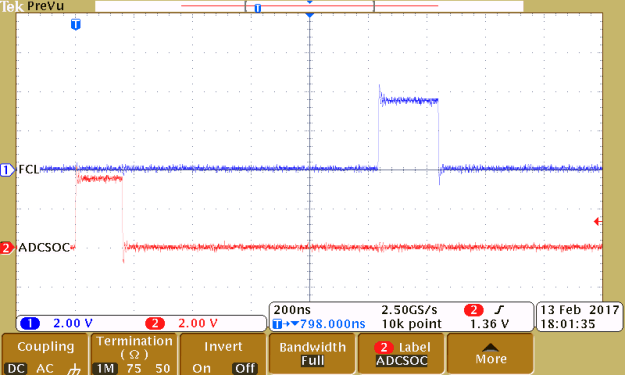SPRACM9B June 2019 – November 2020 TMS320F28384D , TMS320F28384S , TMS320F28386D , TMS320F28386S , TMS320F28388D , TMS320F28388S , TMS320F28P650DH , TMS320F28P650DK , TMS320F28P650SH , TMS320F28P650SK , TMS320F28P659DH-Q1 , TMS320F28P659DK-Q1 , TMS320F28P659SH-Q1
- Trademarks
- 1 Introduction
- 2 Benefits of the TMS320F2838x MCU for High-Bandwidth Current Loop
- 3 Current Loops in Servo Drives
- 4 Outline of the Fast Current Loop Library
- 5 Fast Current Loop Evaluation
- 6 Incremental Build Level 1
- 7 Incremental Build Level 2
- 8 Incremental Build Level 3
- 9 Incremental Build Level 4
- 10Incremental Build Level 5
- 11Incremental Build Level 6
- 12Incremental Build Level 7
- 13Incremental Build Level 8
- 14References
- 15Revision History
8.1.2 From the Scope Plot
Because H7 is not populated, GPIO16 and GPIO18 are used for timing purposes instead of for designed functional assignment. If H7 is to become populated, comment out the associated code and restore the functional assignment.
Figure 8-3 shows the latency discussed previously in the form of a scope plot, where the rising edge of the channel 2 and channel 1 waveforms signify the instances of the ADC SoC event and completion of all PWM updates, respectively. These events are brought out over GPIO16 and GPIO18, and may be probed over [Main]-R31 and [Main]-R33, respectively. The time seen in the scope plot may be slightly more than fclLatencyInMicroSec. This additional time is needed for the CPU to return from FCL library and to set GPIO .
 Figure 8-3 Scope Plot of ADCSoC and FCL Completion Events
Figure 8-3 Scope Plot of ADCSoC and FCL Completion Events